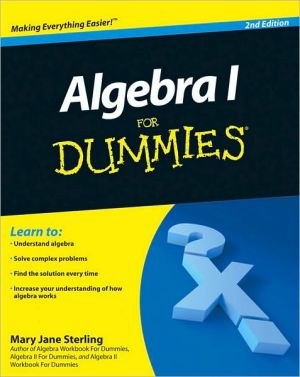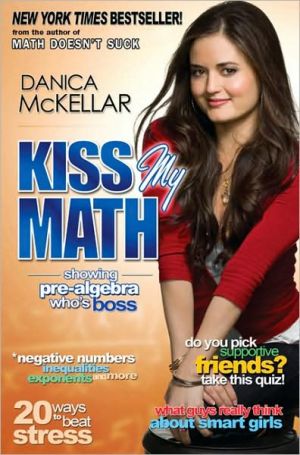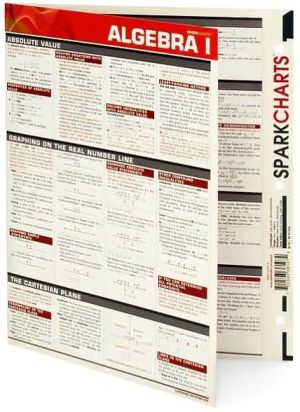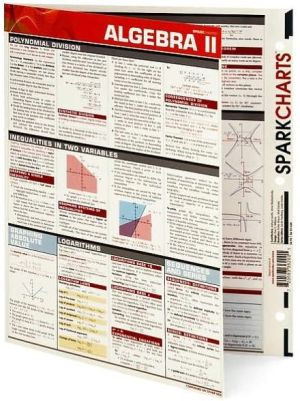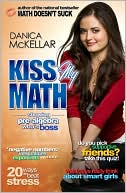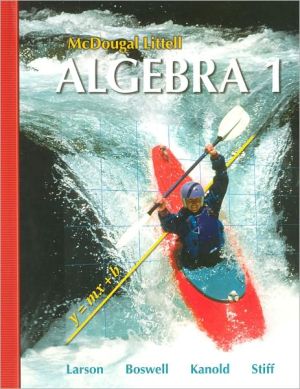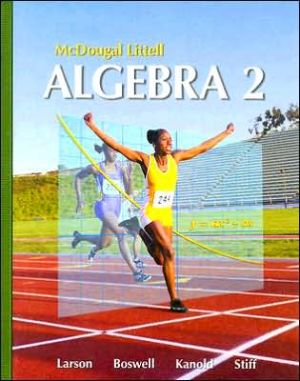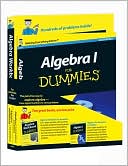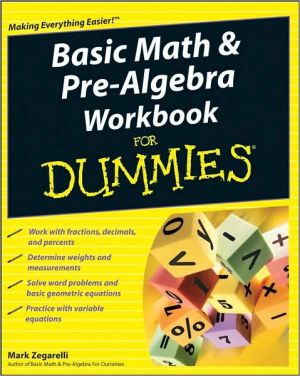Algebra I For Dummies
Factor fearlessly, conquer the quadratic formula, and solve linear equations\ There's no doubt that algebra can be easy to some while extremely challenging to others. If you're vexed by variables, Algebra I For Dummies, 2nd Edition provides the plain-English, easy-to-follow guidance you need to get the right solution every time!\ Now with 25% new and revised content, this easy-to-understand reference not only explains algebra in terms you can understand, but it also gives you the necessary...
Search in google:
Algebra touches everyone's lives, from calculating mortgage interest to going dutch at a restaurant - and it is a required course for nearly two million high school students yearly. This friendly guide covers fractions to quadratic equations. It includes real-world examples and story problems that will help even the most entrenched algebra phobes approach the subject with ease. This book will satisfy the high school student or lifelong learner.
Algebra For Dummies\ \ By Mary Jane Sterling \ John Wiley & Sons\ ISBN: 0-7645-5325-9 \ \ \ Chapter One\ Assembling Your Tools\ In This Chapter\ * Nailing down the basics: Numbers\ * Recognizing the players: Variables and signs\ * Grouping terms and operations together\ * Playing the game and following the rules\ You probably have heard the word algebra on many occasions and knew that it had something to do with mathematics. Perhaps you remember that algebra has enough information to require taking two separate high school algebra classes - Algebra I and Algebra II. But what exactly is algebra? What is it really used for?\ This chapter answers these questions and more, providing the straight scoop on some of the contributions to algebra's development, what it's good for, how algebra is used, and what tools you need to make it happen.\ In a nutshell, algebra is a way of generalizing arithmetic. Through the use of variables that can generally represent any value in a given formula, general formulas can be applied to all numbers. Algebra uses positive and negative numbers, integers, fractions, operations, and symbols to analyze the relationships between values. It's a systematic study of numbers and their relationship, and it uses specific rules.\ For example, the formula a × 0 = 0 shows that any real number, represented here by the a, multiplied by zero always equals zero. (For more information on themultiplication property of zero, see Chapter 14.)\ In algebra, by using an x to represent the number two, for example in x + x + x = 6, you can generalize with the formula 3x = 6.\ You may be thinking, "That's great and all, but come on. Is it really necessary to do that - to plop in letters in place of numbers and stuff?" Well, yes. Early mathematicians found that using letters to represent quantities simplified problems. In fact, that's what algebra is all about - simplifying problems.\ The basic purpose of algebra has been the same for thousands of years: to allow people to solve problems with unknown answers.\ Beginning with the Basics: Numbers\ Where would mathematics and algebra be without numbers? A part of everyday life, numbers are the basic building blocks of algebra. Numbers give you a value to work with.\ Where would civilization be today if not for numbers? Without numbers to figure the total cubits, Noah couldn't have built his ark. Without numbers to figure the distances, slants, heights, and directions, the pyramids would never have been built. Without numbers to figure out navigational points, the Vikings would never have left Scandinavia. Without numbers to examine distance in space, humankind could not have landed on the moon.\ Even the simple tasks and the most common of circumstances require a knowledge of numbers. Suppose that you wanted to figure the amount of gasoline it takes to get from home to work and back each day. You need a number for the total miles between your home and business and another number for the total miles your car can run on one gallon of gasoline.\ The different sets of numbers are important because what they look like and how they behave can set the scene for particular situations or help to solve particular problems. It's sometimes really convenient to declare, "I'm only going to look at whole-number answers," because whole numbers do not include fractions. This may happen if you're working through a problem that involves a number of cars. Who wants half a car?\ Algebra uses different sets of numbers, such as whole numbers and those that follow here, to solve different problems.\ Really real numbers\ Real numbers are just what the name implies. In contrast to imaginary numbers, they represent real values - no pretend or make-believe. Real numbers, the most inclusive set of numbers, comprise the full spectrum of numbers; they cover the gamut and can take on any form - fractions or whole numbers, decimal points or no decimal points. The full range of real numbers includes decimals that can go on forever and ever without end. The variations on the theme are endless.\ For the purposes of this book, I always refer to real numbers.\ Counting on natural numbers\ A natural number is a number that comes naturally. What numbers did you first use? Remember someone asking, "How old are you?" You proudly held up four fingers and said, "Four!" The natural numbers are also counting numbers: 1, 2, 3, 4, 5, 6, 7, and so on into infinity.\ You use natural numbers to count items. Sometimes the task is to count how many people there are. A half-person won't be considered (and it's a rather grisly thought). You use natural numbers to make lists.\ Wholly whole numbers\ Whole numbers aren't a whole lot different from the natural numbers. The whole numbers are just all the natural numbers plus a zero: 0, 1, 2, 3, 4, 5, and so on into infinity.\ Whole numbers act like natural numbers and are used when whole amounts (no fractions) are required. Zero can also indicate none. Algebraic problems often require you to round the answer to the nearest whole number. This makes perfect sense when the problem involves people, cars, animals, houses, or anything that shouldn't be cut into pieces.\ Integrating integers\ Integers allow you to broaden your horizons a bit. Integers incorporate all the qualities of whole numbers and their opposites, or additive inverses of the whole numbers (refer to the "Operating with opposites" section in this chapter for information on additive inverses). Integers can be described as being positive and negative whole numbers: ... -3, -2, -1,0,1,2,3 ....\ Integers are popular in algebra. When you solve a long, complicated problem and come up with an integer, you can be joyous because your answer is probably right. After all, it's not a fraction! This doesn't mean that answers in algebra can't be fractions or decimals. It's just that most textbooks and reference books try to stick with nice answers to increase the comfort level and avoid confusion. This is the plan in this book, too. After all, who wants a messy answer, even though, in real life, that's more often the case.\ Being reasonable: Rational numbers\ Rational numbers act rationally! What does that mean? In this case, acting rationally means that the decimal equivalent of the rational number behaves. The decimal ends somewhere, or it has a repeating pattern to it. That's what constitutes "behaving." Some rational numbers have decimals that end in 2, 3.4, 5.77623, -4.5. Other rational numbers have decimals that repeat the same pattern, such as 3.164164164 ... = 3.[bar.164], or .666666666 .[bar.6]. The horizontal bar over the 164 and the 6 lets you know that these numbers repeat forever.\ In all cases, rational numbers can be written as a fraction. They all have a fraction that they are equal to. So one definition of a rational number is any number that can be written as a fraction.\ Restraining irrational numbers\ Irrational numbers are just what you may expect from their name - the opposite of rational numbers. An irrational number cannot be written as a fraction, and decimal values for irrationals never end and never have a nice pattern to them. Whew! Talk about irrational! For example, pi, with its never-ending decimal places, is irrational.\ Evening out even and odd numbers\ An even number is one that divides evenly by two. "Two, four, six, eight. Who do we appreciate?"\ An odd number is one that does not divide evenly by two. The even and odd numbers alternate when you list all the integers.\ Varying Variables\ Variable is the most general word for a letter that represents the unknown, or what you're solving for in an algebra problem. A variable always represents a number.\ Algebra uses letters, called variables, to represent numbers that correspond to specific values. Usually, if you see letters toward the beginning of the alphabet in a problem, such as a, b, or c, they represent known or set values, and the letters toward the end of the alphabet, such as x, y, or z, represent the unknowns, things that can change, or what you're solving for.\ The following list goes through some of the more commonly used variables.\ \ An n doesn't really fall at the beginning or end of the alphabet, but it's used frequently in algebra, often representing some unknown quantity or number - probably because n is the first letter in number.\ \ \ The letter x is often the variable you solve for, maybe because it's a letter of mystery: X marks the spot, the x-factor, The X Files. Whatever the reason x is so popular as a variable, the letter also is used to indicate multiplication. You have to be clear, when you use an x, that it isn't taken to mean multiply.\ \ \ ITLITL and k are two of the more popular letters used for representing known amounts or constants. The letters that represent variables and numbers are usually small case: a, b, c, and so on. Capitalized letters are used most commonly to represent the answer in a formula, such as the capital A for area of a circle equals pi times the radius squared, A [[pi]r.sup.2] = . (You can find more information on the area of a circle in Chapter 17.) The letter ITLITL, mentioned previously as being a popular choice for a constant, is used frequently in calculus and physics, and it's capitalized there - probably more due to tradition than any good reason.\ \ Speaking in Algebra\ Algebra and symbols in algebra are like a foreign language. They all mean something and can be translated back and forth as needed. It's important to know the vocabulary in a foreign language; it's just as important in algebra.\ \ An expression is any combination of values and operations that can be used to show how things belong together and compare to one another. 2[x].sup.2] + x + is an example of an expression.\ \ \ A term, such as 4xy, is a grouping together of one or more factors (variables and/or numbers). Multiplication is the only thing connecting the number with the variables. Addition and subtraction, on the other hand, separate terms from one another. For example, the expression 3xy + 5x - 6 has three terms.\ \ \ An equation uses a sign to show a relationship - that two things are equal. By using an equation, tough problems can be reduced to easier problems and simpler answers. An example of an equation is 2[chi square] + 4x = 7. See the chapters in Part III for more information on equations.\ \ \ An operation is an action performed upon one or two numbers to produce a resulting number. Operations are addition, subtraction, multiplication, division, square roots, and so on. See Chapter 6 for more on operations.\ \ \ A variable is a letter that always represents a number, but it varies until it's written in an equation or inequality. (An inequality is a comparison of two values. See more on inequalities in Chapter 16.) Then the fate of the variable is set - it can be solved for, and its value becomes the solution of the equation.\ \ \ A constant is a value or number that never changes in an equation - it's constantly the same. Five (5) is a constant because it is what it is. A variable can be a constant if it is assigned a definite value. Usually, a variable representing a constant is one of the first letters in the alphabet. In the equation a [chi square] bx + c = 0, a, b, and c are constants and the x is the variable. The value of x depends on what a, b, and c are assigned to be.\ \ \ An exponent is a small number written slightly above and to the right of a variable or number, such as the 2 in the expression [3.sup.2]. It's used to show repeated multiplication. An exponent is also called the power of the value. For more on exponents, see Chapter 4.\ \ Taking Aim at Algebra Operations\ In algebra today, a variable represents the unknown (see more on variables in the "Speaking in Algebra" section earlier in this chapter). Before the use of symbols caught on, problems were written out in long, wordy expressions. Actually, using signs and operations was a huge breakthrough. First, a few operations were used, and then algebra became fully symbolic. Nowadays, you may see some words alongside the operations to explain and help you understand, like having subtitles in a movie. Look at this example to see what I mean. Which would you rather write out:\ The number of quarts of water multiplied by six and then that value added to three\ or\ 6x + 3?\ I'd go for the second option. Wouldn't you?\ By doing what early mathematicians did - letting a variable represent a value, then throwing in some operations (addition, subtraction, multiplication, and division), and then using some specific rules that have been established over the years - you have a solid, organized system for simplifying, solving, comparing, or confirming an equation. That's what algebra is all about: That's what algebra's good for.\ Deciphering the symbols\ The basics of algebra involve symbols. Algebra uses symbols for quantities, operations, relations, or grouping. The symbols are shorthand and are much more efficient than writing out the words or meanings. But you need to know what the symbols represent, and the following list shares some of that info.\ \ + means add or find the sum, more than, or increased by; the result of addition is the sum.\ \ \ - means subtract or minus or decreased by or less; the result is the difference.\ \ \ x means multiply or times. The values being multiplied together are the multipliers or factors; the result is the product. Some other symbols meaning multiply can be grouping symbols: ( ), , { }, ,* : . In algebra, the x symbol is used infrequently because it can be confused with the variable x. The dot is popular because it's easy to write. The grouping symbols are used when you need to contain many terms or a messy expression.\ \ Continues...\ \ \ \ \ Excerpted from Algebra For Dummies by Mary Jane Sterling Excerpted by permission.\ All rights reserved. No part of this excerpt may be reproduced or reprinted without permission in writing from the publisher.\ Excerpts are provided by Dial-A-Book Inc. solely for the personal use of visitors to this web site. \ \
Introduction.About This Book.What Not to Read.Foolish Assumptions.How This Book Is Organized.Where to Go from Here.Part I: Starting Off with the Basics.Chapter 1: Assembling Your Tools.Beginning with the Basics: Numbers.Varying Variables.Speaking in Algebra.Taking Aim at Algebra Operations.Playing by the Rules.Chapter 2: Assigning Signs: Positive and Negative Numbers.Showing Some Signs.Going In for Operations.Operating with Signed Numbers.Working with Nothing: Zero and Signed Numbers.Associating and Commuting with Expressions.Chapter 3: Figuring Out Fractions and Dealing with Decimals.Pulling Numbers Apart and Piecing Them Back Together.Following the Sterling Low-Fraction Diet.Fitting Fractions Together.Putting Fractions to Task.Dealing with Decimals.Chapter 4: Exploring Exponents and Raising Radicals.Multiplying the Same Thing Over and Over and . . . .Exploring Exponential Expressions.Multiplying Exponents.Dividing and Conquering.Testing the Power of Zero.Working with Negative Exponents.Powers of Powers.Squaring Up to Square Roots.Chapter 5: Doing Operations in Order and Checking Your Answers.Ordering Operations.Checking Your Answers.Writing Understandable Answers.Chapter 6: Prepping for Operations.Realizing Some Restrictions.Representing Numbers with Letters.Doing the Math.Multiplying and Dividing Variables.Doing It All.Part II: Figuring Out Factoring.Chapter 7: Working with Numbers in Their Prime.Beginning with the Basics.Composing CompositeNumbers.Writing Prime Factorizations.Getting Down to the Prime Factor.Chapter 8: Sharing the Fun: Distributing.Giving One to Each.Distributing Signs.Mixing It Up with Numbers and Variables.Distributing More than One Term.Making Special Distributions.Chapter 9: Factoring in the First Degree.Factoring.Grouping Terms.Chapter 10: Getting the Second Degree.The Standard Quadratic Expression.Reining in Big Numbers.FOILing.UnFOILing.Factoring Several Expressions.Chapter 11: Factoring Special Cases.Befitting Binomials.Tinkering with Trinomials and More.Knowing When to Quit.Part III: Working Equations.Chapter 12: Lining Up for Linear Equations.Solving with Division.Solving with Multiplication.Solving with Reciprocals.Setting Up Equations.Chapter 13: Solving Linear Equations.Keeping Equations Balanced.Playing by the Rules.Balancing Fractions.Solving for Variables.Getting Impossible Answers.Chapter 14: Taking a Crack at Quadratic Equations.Squaring Up to Quadratics.Rooting Out Another Result from Quadratic Equations.Factoring for a Solution.Solving Quadratics with Three Terms.Applying Quadratic Solutions.Figuring Out the Quadratic Formula.Chapter 15: Distinguishing Equations with Distinctive Powers.Queuing Up to Cubic Equations.Working Quadratic-Like Equations.Rooting Out Radicals.Dividing Synthetically.Chapter 16: Fixing Inequalities.Operating on Inequalities.Solving Linear Inequalities.Working with More Than Two Expressions.Solving Quadratic Inequalities.Working with Absolute Value Inequalities.Part IV: Applying Algebra.Chapter 17: Making Formulas Behave.Measuring Up.Spreading Out: Area Formulas.Pumping Up with Volume Formulas.Going the Distance with Distance Formulas.Calculating Interest and Percent.Working Out the Combinations and Permutations.Formulating Your Own Formulas.Chapter 18: Sorting Out Story Problems.Setting Up to Solve Story Problems.Working Around Perimeter, Area, and Volume.Making Up Mixtures.Going the Distance.Righting Right Triangles.Going 'Round in Circles.Chapter 19: Going Visual: Graphing.Graphing is Good.Grappling with Graphs.Actually Graphing Points.Graphing a Line.Investigating Intercepts.Sighting the Slope.Marking Parallel and Perpendicular Lines.Intersecting Lines.Curling Up with Parabolas.Part V: The Part of Tens.Chapter 20: The Ten Most Common Errors.Missing Middle Term.Distributing.Breaking Up Fractions.Breaking Up Radicals.Order of Operations.Fractional Exponents.Multiplying Bases Together.A Power to a Power.Reducing.Negative Exponents.Chapter 21: Ten Ways to Factor a Polynomial.Two Terms with a GCF.The Difference of Two Squares.The Difference of Two Cubes.The Sum of Two Cubes.Three Terms with a GCF.Three Terms with unFOIL.Changing to Quadratic-Like.Four or More Terms with a GCF.Four or More Terms with Equal Grouping.Four or More Terms with Unequal Grouping.Chapter 22: Ten Divisibility Rules.Divisibility by 2.Divisibility by 3.Divisibility by 4.Divisibility by 5.Divisibility by 6.Divisibility by 8.Divisibility by 9.Divisibility by 10.Divisibility by 11.Divisibility by 12.Chapter 23: Ten Tips for Dealing with Story Problems.Draw a Picture.Make a List.Assign Variables to Represent Numbers.Translate Conjunctions and Verbs.Look at the Last Sentence.Find a Formula.Simplify by Substituting.Solve an Equation.Check for Sense.Check for Accuracy.Glossary.Index.Book Registration Information.
